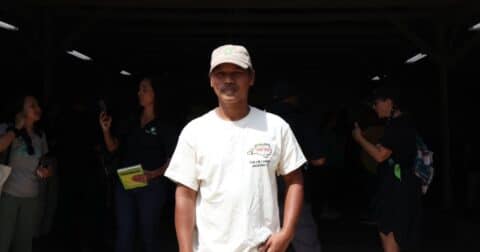News
L.A.’s Meatpacking Industry Is a Lot Like the Rest of the Country. Experts Say Here’s How to Make it Safer.
Food•4 min read
Solutions
Once a contract chicken farmer, Tom Lim is farming his way out of debt with greens and mushrooms.


Words by Dawn Attride
Tom and Sokchea Lim’s farm looks the same as any other factory chicken farm on the outside: four large barns on 28 acres of land, built to house thousands of clucking chickens at a time. Yet, three of the barns are now silent and empty, with no trace of livestock, except for the eye-watering stench of ammonia and red plastic feeders hanging from the rafters — the only signs there were ever chickens here. In the last barn, a large group of people are excitedly huddled on a humid September day to celebrate the Lims’ unveiling of their chicken barn-turned-greenhouse. It’s hard to believe this new greenhouse, filled with light and a myriad of greenery, once looked like the dark, musty barns adjacent to it.
Lim’s repurposed farm is a funded project of Transfarmation, a Mercy for Animals initiative that aims to end factory farming — to improve both animal and farmer welfare — by transitioning farmers to growing crops. At the door of the greenhouse, Tom Lim and Leah Garcés, Transfarmation’s founder and book author, snip a red ribbon to mark the public opening of the project.
In this airy 15,000-square-foot greenhouse, Lim grows tomatoes, squash, lettuce and peppers amongst other crops. Previously, the farm raised 540,000 chickens a year in all four barns when they were in production. Lim also grows oyster mushrooms in an insulated, food-safe aluminum trailer on the farmland. Collectively, the project will serve not only as Lim’s farm, but as an education hub for factory farmers who want to transition out of the industry they’re often “trapped” in, says Garcés, who is also CEO and President of Mercy For Animals.
For Lim, the opening marks his transition to sustainable farming and a more hopeful future. An immigrant from Cambodia who came to the U.S. more than two decades ago, Lim was able to set up a chicken farm on this land in 1999, just by taking loans from Farm Credit and signing a contract with Pilgrim’s Pride, one of the largest chicken producers in the country. “When I come to the United States, I don’t expect that I can buy any land for business. But you know I did it [and] so I’m very happy,” Lim tells Sentient.
One of Lim’s previous chicken barns, in a state of disrepair. Credit: Dawn Attride
But over the course of the next 20 years, Pilgrim’s Pride, like many other meat processing companies, required Lim to consistently upgrade the chicken barns to meet new standards — on top of paying off his existing loans with agricultural lenders Farm Credit. “The company forced me to do a lot of upgradings and installing new stuff and I cannot afford it. And they say if I cannot do any upgrade, they will cut me off and let me go,” Lim says. Although he took out more loans from banks to keep up with the company’s demands, he says he was eventually let go in 2018, leaving him and his family with debilitating debt.
This cycle of debt is what keeps farmers trapped and from speaking up, Garcés tells Sentient.“If they try to fight against the system, they risk losing their contract and then losing everything.”
After he was laid off, Tom and his wife Sokchea worked multiple jobs, seven days a week, to try to keep up with the debt. In 2022, he reached out to Transfarmation for help and so, the idea for converting his chicken barn into a greenhouse and eventually, a demonstration hub for other farmers, was born. Although Lim has not fully paid off the debt he’s accrued — more than $150,000 — he is hopeful the greenhouse crops will reap enough financial reward in the long term to make the farm profitable.
Large meat processing companies like Perdue and Pilgrim’s Pride pay contract poultry farmers as little as five cents per pound of chicken, and pay nothing if their chickens die from disease, for example. This measly pay, coupled with the debt and barn upgrades, means some farmers barely have enough to pay themselves an hourly wage, let alone any kind of profit, says Tyler Whitley, Transfarmation’s director.
As Lim leads the gaggle of attendees on a tour through his greenhouse, he explains the various growing systems and their crops, grown from organic seeds and in organic soil. Although he is not yet organic certified, he hopes to pursue the certification so he can access the higher price point markets and help his financial bottom line.
Organic vegetable farms use fewer synthetic pesticides and no synthetic fertilizers at all, among other federal requirements for certification. Lim has already contracted customers for much of his produce; buttercrunch lettuce, mushrooms and red swiss chard to Fresh Point distributors, and beets, lettuce and mushrooms to Sandhill Farm.
Inside the mushroom trailer, oyster mushrooms adorn the metal shelves, bulging outwards from their inoculated blocks made of hardwood sawdust and pulverized soybean hulls — the medium the mushrooms thrive in. The produce from this trailer, which is a little smaller than a caravan, will be enough to pay Lim an hourly wage and profit in full production, Whitley says. In contrast to the low pay for chicken, specialty mushrooms like oyster and shiitake, are high crop earners, garnering up to $15 per pound, or more.
However, this blueprint for a better future required a steep investment from Transfarmation. Repurposing the Lim’s chicken barn involved demolition, replumbing, rewiring and implementing four distinct growing systems, amongst other costly construction, Transfarmation invested roughly $700,000 in the project. Whitley says the conversion was done with longevity and education potential in mind — the hub is built to residential code, with running hot and cold water, power outlets and wifi. The barn’s existing sturdy wooden beam structure remains in place with greenhouse panels made from polycarbonate sheeting, built to last at least 20 years, instead of weaker plastic alternatives.
Not every conversion has to be as large as this one, Whitley says, and the project has served as something of a test case for future Transfarmation farmers. “When other farmers come in, they don’t have to learn the expensive lessons that we’ve learned, and they can do [smaller models] at a much lower cost.” This particular project has taught the Transfarmation team the ideal seasonal growing models for different crops, for instance.
Constructing a demonstration hub is new for Transfarmation. Typically, the organization helps farmers come up with a transition plan on an individual basis, or in some cases, issues innovation grants to make that plan a reality. An important caveat is that Transfarmation doesn’t currently work with farmers who still have large amounts of debt to pay off. “However, the systems and models we’re creating have the potential to service substantially higher levels of debt,” Whitley says.
To bridge that gap, Garcés says debt relief or transition money needs to be granted at the federal level — a cause her team has been actively advocating for the past two years. Earlier this year, they applied for a USDA grant, and regularly look for more opportunities for federal funding of their work.
The seeds of Transfarmation were sowed in 2014 when Garcés met Craig Watts, whose chicken farm was also in North Carolina. “I probably saw that person as my enemy as an animal activist, but he invited me to come on his farm through a mutual friend. And sitting with him, I realized for the first time that chicken factory farmers are almost as trapped as the chickens [and] this was a system that oppressed them as well,” Garcés says.
The two began working together to share his story and leave factory farming behind for mushroom growing. This relationship spurred Garcés to found Transfarmation in 2019. “Within the first few months we had hundreds of farmers writing to us and we realized we had really hit on something important, a missing link in breaking factory farming down,” Garcés tells Sentient.
Lim and Watts represented just two cogs of the machine that is North Carolina’s biggest, booming agricultural business, which employs over 100,000 farmers: poultry. A recent Environmental Working Group study, using artificial intelligence and aerial surveillance from the state’s department of agriculture, found poultry farms house 357 million birds annually. That’s up 43 percent since 2007, in response to growing demand.
But the pollutant-heavy Big Poultry industry has left its mark on the state. A Charlotte Observer investigation found North Carolina’s chickens produce more waste than nearly 72 percent of the state’s population. This waste flows into rivers and streams as a result of the state’s lack of industry regulation. The investigation also found the state “shields the locations of poultry farms,” which 230,000 residents currently live half a mile from and have no right to object to. People who live near these farms are at risk of respiratory problems from inhaling polluted air and drinking contaminated water.
While Transfarmation did not comment specifically on how many farmers want to get out of the poultry industry in North Carolina, they said they receive hundreds of requests for help from all over the country. For now, the Transfarmation team hopes the hub — and others they intend to build — will serve as a learning experience for those seeking to escape the grasp of factory farming. And for Tom and Sokchea Lim, the experience has been transformative: “I’m very excited to see the conversion of my whole barn to an educational greenhouse. I didn’t really think [it was possible], but it happened, so I’m very happy,” Tom Lim says, smiling.